UK immigration policy after leaving the EU: impacts on Scotland's economy, population and society
Debut report by independent Expert Advisory Group on Migration and Population looks specifically at how the ending of free movement and future UK Immigration policy will affect Scotland's devolved responsibilities.
2. Migration to Scotland
This chapter briefly summarises recent trends in migration to Scotland, and provides an overview of the characteristics of migrants, including main reasons for migration, occupations, age and sex, and geographical distribution across Scotland. It then considers how the proposed changes to free movement and UK immigration rules are likely to affect these trends, setting out different scenarios for migration flows to Scotland after 2020.
2.1 Recent migration trends
Migration flows
Scotland experienced a period of negative net migration from the 1950s until the late 1980s (more outflows than inflows into the country). However, from the early 2000s, the country –- saw positive net migration both from overseas and the rest of the UK (rUK) (Figure 2.1).
Figure 2.1: Net migration to Scotland (International and rUK), 1951-2016
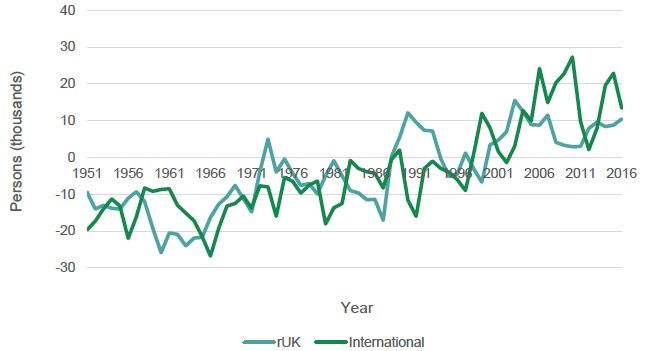
Source: NRS
Average net migration from mid-2001 to mid-2017 was around +21,000 individuals a year (Figure 2.2). The analysis shows that net migration to Scotland has been positive for both overseas migrants, and for those from rUK, although overseas migration has seen greater fluctuation (Figure 2.3).
Figure 2.2: In- and out-migration from Scotland, 2001-2017
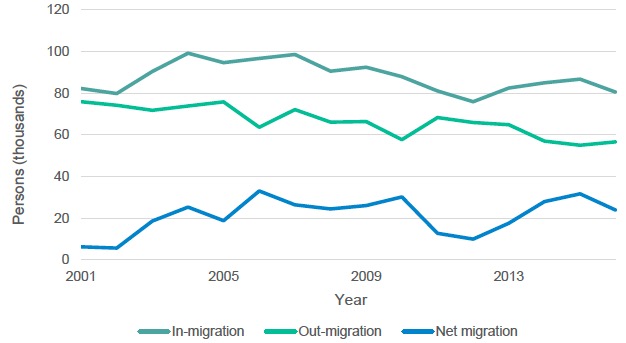
Source: NRS
Figure 2.3: Net migration rate in Scotland, 2001-2017[3]
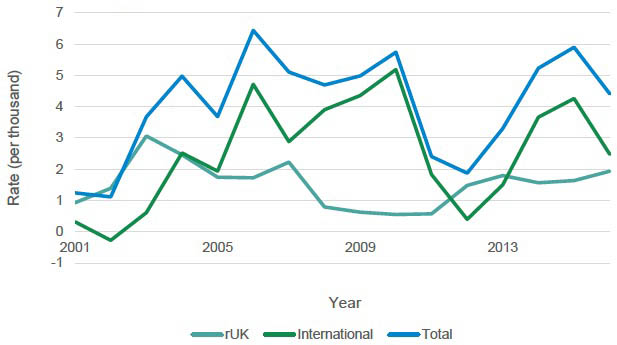
Source: NRS
Over the past decade, an estimated 45% of migrants to Scotland from overseas have come from EU countries. Comparing Scotland with the UK, we can see that, overall, the trends are similar, although the data suggest that the number of people arriving from EU countries relative to those leaving for the EU has been larger for Scotland than for the UK (Figure 2.4). However, we note the need for caution in analysing data by country of origin, given the small sample sizes for Scotland in the International Passenger Survey (IPS) and the LFS.
Recent estimates suggest that immigration from EU countries to Scotland and the UK is decreasing. IPS estimates for Scotland suggest a decrease in inflows and an increase in outflows in 2017, compared to the two previous years. Particularly striking is the decline in EU-8 immigration to Scotland, with estimated inflows at 1,700, significantly lower than the average of 4,850 over the previous ten years, and at their lowest point since 2006 (with the exception of the year after the financial crisis, 2008). This may reflect economic conditions in the UK (for example the falling value of sterling), as well as uncertainties around leaving the EU and the anticipated end of free movement rights.[4] It may also reflect a decline in the pool of potential emigrants from EU-8 countries, due to rising employment opportunities and income in countries of origin and the declining size of young adults' cohorts.
Figure 2.4: Share of EU migrants among international migrants in Scotland and the UK, 2001-2017
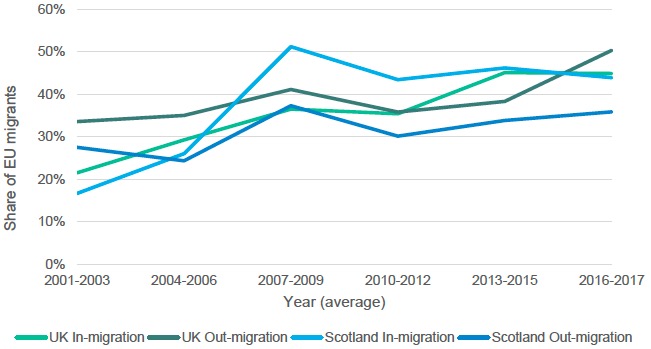
Source: ONS
Reasons for migration to Scotland
Most EU nationals come to the UK to work. Estimates for 2013-2017 suggest that 67% of immigrants from EU countries came to the UK either with a definite job or to look for work. A further 19% entered to study, and 9% to join family. Moreover, a proportion of those who entered for the purpose of study or to join family may also go on to become economically active. Conversely, the cohorts of younger EU nationals who have settled in the UK since the 1990s will eventually become pensioners.
The proportion of non-EU entrants entering for work reasons was somewhat lower, estimated at 28% for the period 2013-2017. This reflects the more restricted possibilities for non-EU nationals to live and work in the UK. A larger proportion (48%) entered to study, and a further 19% to join family. Again, it should be noted that some family members may become economically active after they arrive, while some students may also switch to work routes.
Figure 2.5: Reason for immigration to the UK by citizenship, 2013-2017
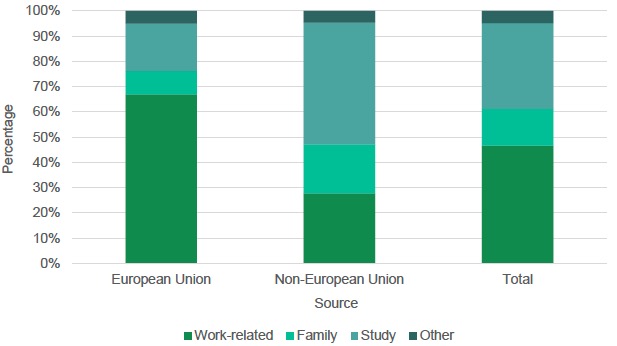
Source: NRS
Migrants from EU countries tend to be younger than the average population. Figure 2.6 shows that immigration from overseas to Scotland has been dominated by those aged 20-29, with the proportion rising after the EU-8 accession in 2004. The high proportion of 20-24 year olds is partly accounted for by student migration; while the overall preponderance of 20-29 year olds reflects the fact that many young people move at the beginning of their career to enhance their job prospects, and prior to starting a family.
Figure 2.6: In-migration rate from overseas in Scotland, 2001-2016
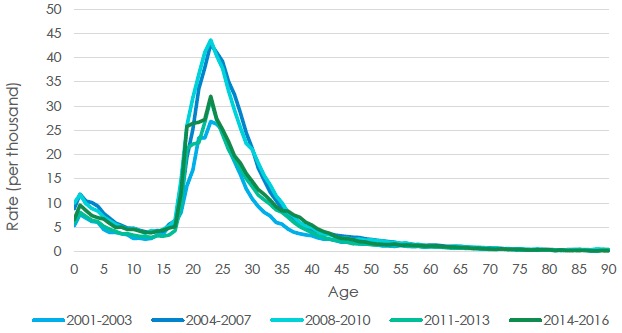
Source: NRS
2.2 Sectors of Employment and Occupations
We now examine the distribution of migrant workers across the labour market using the APS and the LFS. Although these surveys provide the best available information on migrants, it is possible that they underestimate levels of migration. The reasons for this include non-sampling of communal establishments such as halls of residence, language difficulties and/or reticence in responses to interview questions, especially if work status has not been established. In particular, the LFS and the APS are unlikely to capture the role of seasonal agricultural workers accurately. Country of birth is classified either as the UK; the EU-15; the EU-10; or other non‑UK countries.
We start by examining how economic activity varies across these country-of-birth classifications. Figure 2.7 shows how they vary by economic activity in Scotland. Employment accounts for more than 50% of activity across all groups, but is particularly high for those from the EU-10 countries. A relatively large proportion of residents in Scotland born in the EU-15 are students. The distribution of economic activity among those born outside the EU more closely resembles that of the UK-born than either the EU-15 or EU-10. The proportion of self-employed individuals from the EU-10 and EU-15 (not including the UK) exceeds that of the UK-born: around 7.5% of EU migrants to Scotland are self-employed. Setting tight criteria on access to the UK labour market for the self-employed is likely to limit growth in firm formation in Scotland, which already lags behind the rest of the UK.
Figure 2.7: Economic Activity by Country of Birth
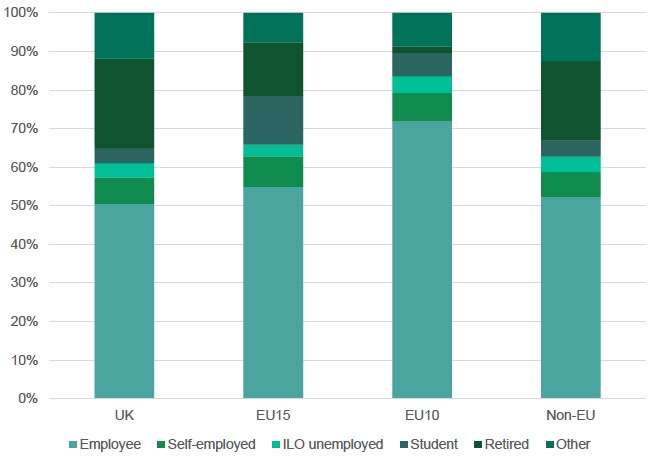
Source: ONS Annual Population Survey 2013-2017
Figure 2.8 shows the distribution of employment across Scottish industries by country of birth. It shows those sectors that are more dependent on migrant labour, and how this reliance on migrants is distributed between the EU-15, the EU-10 and other non-EU countries. Note that 'UK' includes those born in Scotland and the UK as a whole.
Figure 2.8: Employment Shares by Country of Birth and Broad Industry
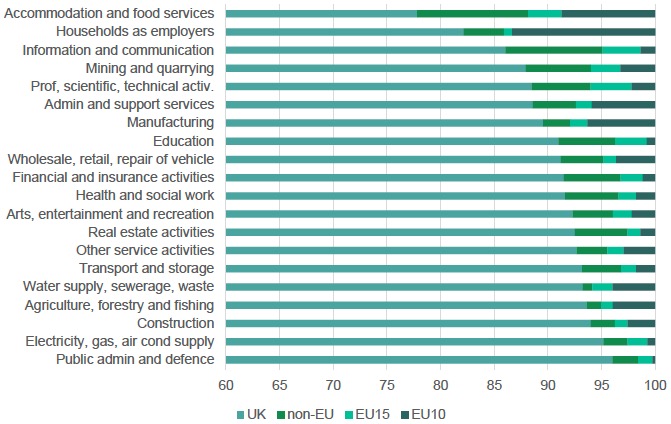
Source: ONS Annual Population Survey 2013-2017
Accommodation and food services, which mainly comprise hotels and restaurants, are most dependent on migrants, with almost 22% of the workforce born outside the UK. These services form the main component of the tourism sector, which contributes around £6 billion to Scottish GDP, or 5% of total value-added.[5] This is also a growing sector, with the number of overseas visitors to Scotland increasing by 17% between 2011 and 2016.
Dependency on migrant workers is high in many other sectors, with the number born in the EU considerably exceeding those born outside the EU. Exceptions are sectors which require advanced qualifications, such as education, finance, health and IT, where there is a similar or slightly larger share of non-EU nationals.
However, such broad industrial sectors do not capture the detailed picture of dependency on migrant labour. Figure 2.9 provides a breakdown of those industries in Scotland that have more than 10% of their employees born outside the UK. This more detailed disaggregation highlights the role played by EU-10 workers in manufacturing food, leather products and so on. It also highlights the dependency of scientific research, computer programming, film and video production on migrants from the EU-15 countries.
Figure 2.9: Employment Shares by Country of Birth and Detailed Industry
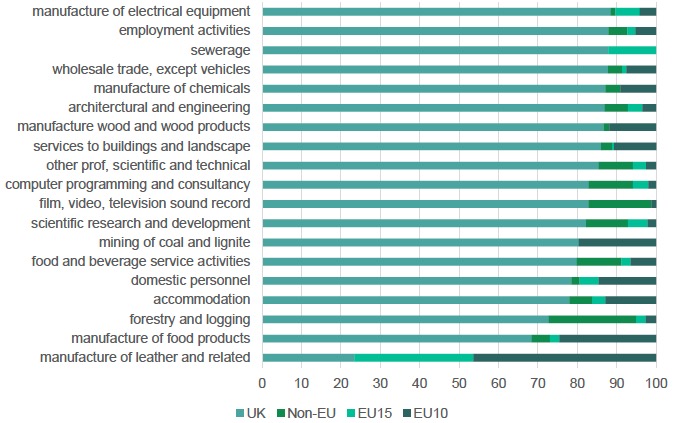
Source: ONS Annual Population Survey 2013-2017
A similar analysis of how migrants are distributed by occupation provides an indication of where gaps may appear in the Scottish labour market should the supply of migrants be significantly reduced. Figure 2.10 shows the migrant shares in those occupations where more than 20% of the workforce was born outside the UK.
The majority of these occupations are not classified as high-skilled. Health professions, science and IT are the main exceptions. In these occupations it is non‑EU and EU-15 countries that dominate the foreign-born employment share, whereas in the less skilled occupations, migrants from EU-10 countries play a much greater role.
The MAC report on EEA Migration in the UK notes that one strategy to offset the effects of a reduction in immigration is to encourage the UK-born to remain longer in the workforce by deferring retirement. However, the UK-born workforce is already relatively old due to Scotland's demography. Table 2.1 shows the mean age of workers by major occupation and country of birth. It clearly shows that almost without exception, the average age of the UK-born exceeds that of migrant workers. The gap between the age of the UK-born and that of EU-10 migrants, who are generally the most recent arrivals, is particularly striking. Policies to encourage the already older UK-born to work longer would have to be introduced as a matter of urgency, given their existing age profile.
Figure 2.10: Employment Shares by Country of Birth and Detailed Occupation
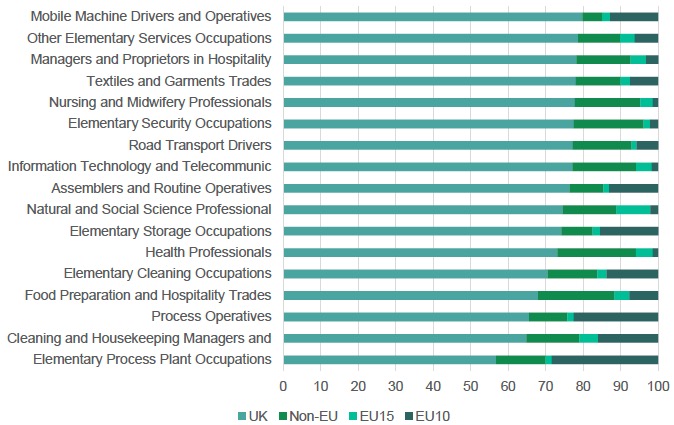
Source: ONS Annual Population Survey 2013-2017
Table 2.1: Mean Age of Workers by Broad Occupation and Country of Birth
| UK |
EU-15 |
EU-10 |
non-EU |
|
|---|---|---|---|---|
| Managers, directors and senior officials |
48.8 |
46.4 |
35.9 |
47.7 |
| Professional occupations |
45.1 |
42.3 |
37.9 |
44.2 |
| Associate professional and technical occupations |
44.0 |
42.1 |
33.4 |
43.0 |
| Administrative and secretarial occupations |
45.0 |
46.0 |
32.9 |
43.8 |
| Skilled trades occupations |
44.7 |
42.7 |
35.2 |
44.0 |
| Caring, leisure and other service occupations |
44.1 |
44.7 |
33.7 |
43.1 |
| Sales and customer service occupations |
38.1 |
35.2 |
32.6 |
36.9 |
| Process, plant and machine operatives |
47.4 |
42.4 |
35.4 |
46.6 |
| Elementary occupations |
41.4 |
35.8 |
34.7 |
39.8 |
Source: ONS Annual Population Survey 2013-2017
Contributions to value added depend not only on the number of workers, but also on the number of hours that they work. Again, there are contrasts between migrants and the UK-born, with the average EU-15 and EU-10 employee working around 5% more hours than their UK-born equivalents. This pattern is reversed among the self‑employed, but since these comprise only 11.5% of all workers, the extra hours worked by employees more than offsets the extra contribution for the UK-born self-employed. Thus, if these working time patterns persist and immigration falls, maintaining current levels of output would require a more than one-for-one replacement of migrant workers by the UK-born.
Figure 2.11: Weekly Hours of Work by Country of Birth and Employment Status
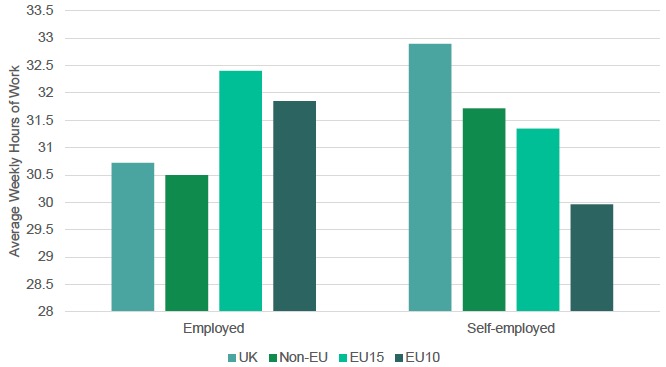
Source: ONS Annual Population Survey 2013-2017
2.3 Geographical Distribution
Over the past five years, the rate of immigration flows to Scotland from overseas has been just under 6.5 per 1,000 head of population per year (see Table 2.2). However, the rate of migration varies across different areas of Scotland. While larger cities have seen an annual immigration rate of almost 16 per 1,000, other types of areas (including remote and rural areas, and urban with substantial rural) have experienced an immigration rate of around 3 per 1,000. This rate is at a lower level than the rate for 2004-08, which saw large numbers of EU-8 nationals move to Scotland following accession in 2004. Figure 2.12 shows this distribution by council area type in Scotland, mapping flows per 1,000 head of population between 2013 and 2017.
Table 2.2: Rates of International In-Migration per 1,000
| 2004-08 |
2013-17 |
|
|---|---|---|
| Larger Cities |
17.78 |
15.94 |
| Urban with Substantial Rural |
3.68 |
2.60 |
| Mainly Rural |
5.05 |
3.05 |
| Islands and Remote Rural |
3.97 |
2.85 |
| Scotland |
7.86 |
6.42 |
Source: NRS Local Area Migration 2017 [6]
Figure 2.12: Overseas In-Migrants per 1,000
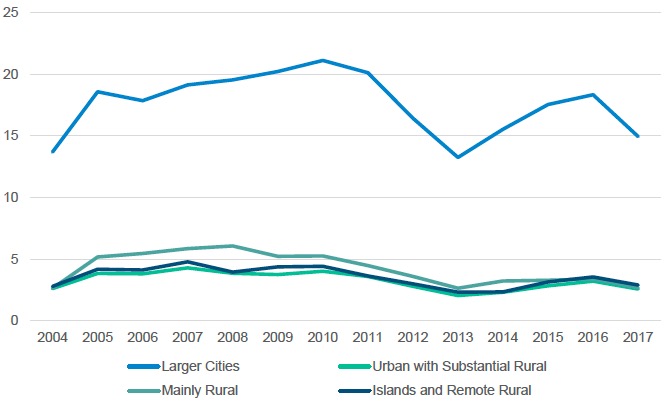
Source: NRS Local Area Migration 2017
Figure 2.13: Overseas Migration per 1,000, 2013-17
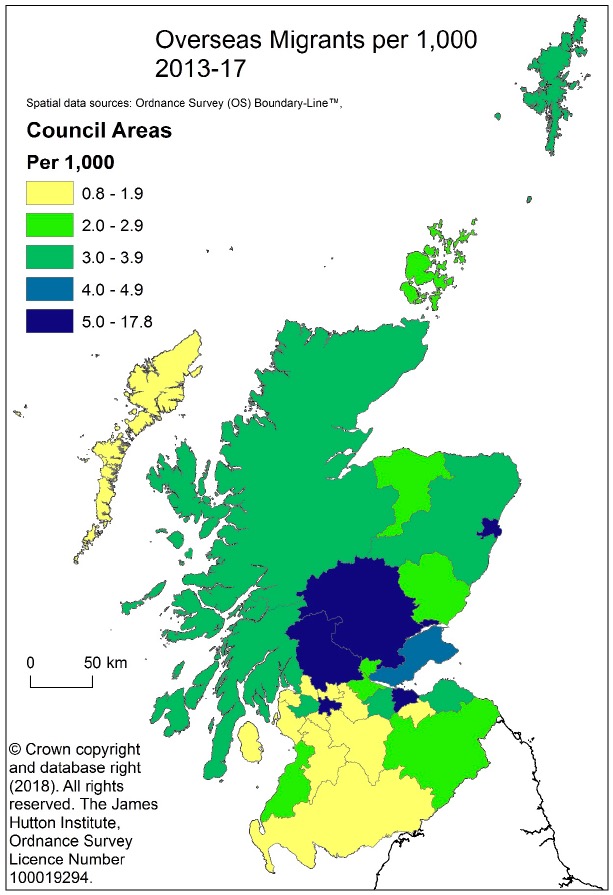
Source: NRS Local Area Migration 2017
We can observe a similar spatial distribution if we look at data on National Insurance registrations (NINOs), which show a concentration of international migrants in the cities. The NINO data also show how the EU-8 accession in 2004 led to a substantial increase in labour migration to all areas of Scotland, including mainly rural and islands and remote rural areas. The NINO figures may be under-representing migration to remoter areas, as non-UK nationals are more likely to move to such locations as secondary destinations, after an initial stay in urban or less remote rural areas.
This is borne out by studies showing how EU migrants, and especially nationals of EU-8 countries, have been distributed across all types of areas of Scotland. This is in contrast to previous migratory movements to Scotland, as well as immigration of non-EU nationals, which have tended to be more strongly concentrated in larger cities. The wider spatial distribution of EU migrants has been linked to the relative lack of restrictions for both migrants and employers within the free movement framework.
Figure 2.14: National Insurance Registrations per 1,000, 2004-2017
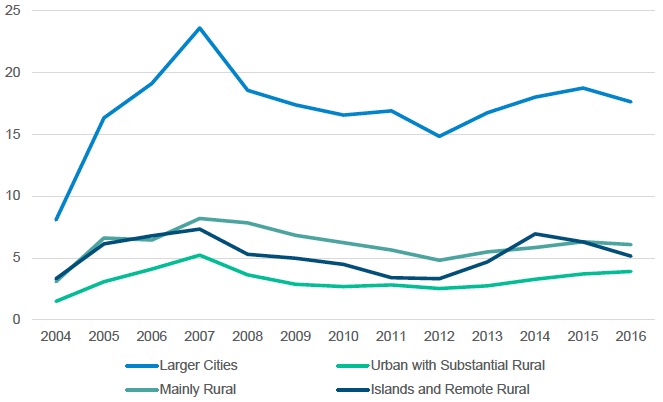
Source: NRS Local Area Migration 2017
Figure 2.15: NINO Registrations per 1,000, 2013-17
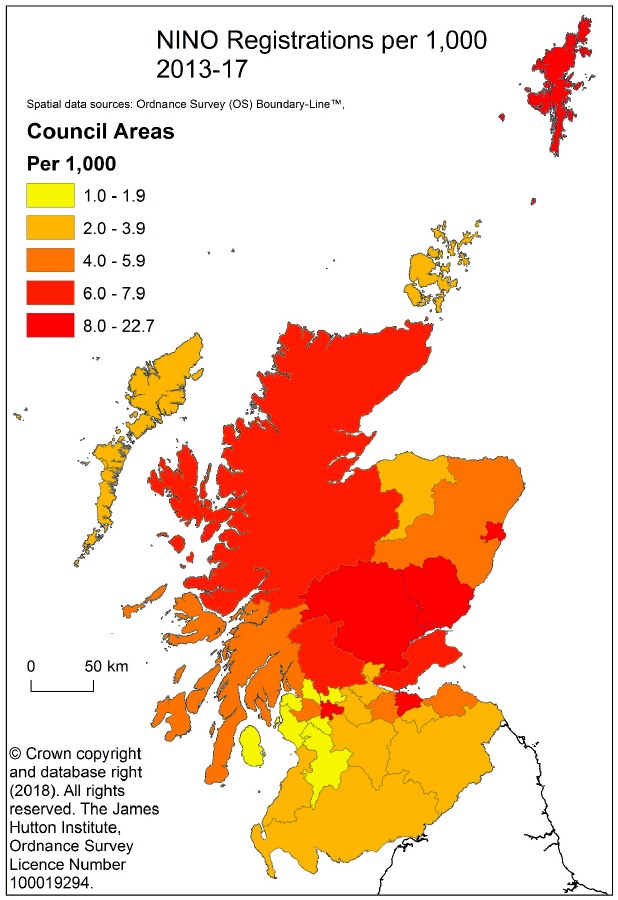
Source: NRS Local Area Migration 2017
These data all help us build up a picture of migration flows into different areas of Scotland. We can also use data on stocks of migrants to understand spatial distribution. Country of birth data from the 2011 census suggests that just under 14% of the population of the city council areas were born outside the UK in 2011. In the three other types of council area the percentage was less than 5%. By the time of the 2017 Population Estimates, the non-UK-born population in city council areas had risen to 17%, while in other types of areas the percentage ranged from 4.4% (in remote and island areas) to just over 6% in the mainly rural areas.
2.4 Future immigration scenarios
The task of this report is to consider how these migration dynamics might be affected by the proposed changes to free movement and UK immigration rules. Decisions on migration and settlement are extremely complex, as they are influenced by a range of economic and social conditions in both sending and receiving countries. This makes it difficult to predict how future policy changes might affect flows. The following factors are likely to influence flows of EU nationals over the coming years:
- changing economic and social conditions in the main countries of origin of EU migrants;
- changing economic and social conditions in the UK;
- changes to UK immigration policy, including the cessation of free movement and adjustments to the immigration system.
This report focuses on the third factor: changes to UK policy. Thus we examine how changes in free movement rights and UK immigration policy might influence migration flows to and from Scotland once the UK has left the EU. Clearly, we would not expect other social and economic conditions to remain the same. Indeed, recent trends in migration suggest that in-flows of EU nationals to the UK have already declined and outflows have increased, possibly in response to economic conditions in the UK and uncertainty about the future status of EU nationals in the UK. Given uncertainties around the main drivers of migration, we will sketch out two scenarios, reflecting different expectations about the immigration decisions of EU nationals.
In order to develop future migration scenarios, we start by defining a baseline projection that gives the assumed level of net migration in the absence of the proposed changes. Our baseline projection assumes that overseas migration flows will remain the same as they have been over the past five years (using the five-year averages for in- and out- migration). This figure, +13,000, is similar to the average net migration between 2001 and 2017 and lower than that in the last ten years. However, these estimates are still much higher than those of the NRS and ONS principal projection, which are based on the average for the previous 25 years.[7] In our projections, we assume the same fertility, mortality and migration levels with the rest of the UK as the NRS and ONS principal projection.
Again basing figures on trends of the past five years, we assume 34,500 immigrants and 21,500 emigrants, implying overseas net migration at +13,000. Of this, we assume 15,500 immigrants come from EU countries annually, and 7,500 leave for the EU, with net migration of +8,000. A further 19,000 come from non-EU countries and 14,000 leave for non-EU countries per year, with net migration of +5,000. We further assume a similar breakdown of immigration by age (see Figure 2.7).
This baseline is then adjusted in line with expected changes in patterns of migration following the proposed policy changes. We expect the major impact on international migration figures to occur in relation to EU immigration, the Tier 2 route, family migration, and long-term settlement decisions. We would also anticipate some changes following the introduction of temporary labour schemes for some sectors. However, we note that immigration through the proposed seasonal workers and transitional temporary routes would not be captured in international migration statistics as it would involve stays of less than 12 months. In the following sections, we outline the main changes we would expect to occur.
EU migration for work
The end of free movement rights after the UK leaves the EU means that citizens of other EU countries will no longer be entitled to access the UK labour market or to be self-employed, except where UK immigration rules allow. EU nationals may work in the UK subject to the immigration rules that apply to non-EU nationals, namely the UK points-based system.
The current UK points-based system
The UK points-based system comprises five tiers for different categories of economic migration from outside the EU. Family migration and humanitarian migration routes (e.g. for asylum seekers) are dealt with outside the points-based system.
- Tier 1 is for 'high-value migrants' and covers entry of entrepreneurs, investors, and a small quota of 'exceptional talent' visas.
- Tier 2 is for 'skilled workers' with a job offer in the UK from an employer who will sponsor their application. It is the main route for workers outside the EU to enter the UK.
- Tier 3 was intended for low-skilled workers but was never implemented. The requirement for low-skilled migrant workers in the UK labour market was largely met by EU nationals exercising free movement rights.
- Tier 4 is for students who wish to study in the UK. Applicants must have a confirmed place at a registered UK educational establishment.
- Tier 5 contains a variety of visa routes temporary workers, including creative, sporting, charity, and religious workers. The youth mobility scheme allowing young people to come to the UK on working holidays also sits within this tier.
Within Tier 1, the 'Exceptional Talent' track applies to leaders or emerging leaders in science, engineering, medicine, digital technology, arts and humanities. However, there is currently a cap of 2,000 on this channel and the White Paper does not propose lifting this cap. The 'Entrepreneur' and 'Investment' tracks apply to those with substantial funds to invest in the UK, and are not likely to apply to a large number of potential migrants; very few of the 7.5% of EU migrants who are self‑employed would have been able to meet these conditions. The MAC estimates average annual income for self-employed EU nationals is well below £30,000. Although they make a significant contribution to value added, there are no new proposals in the White Paper as to the route by which EU nationals might become self-employed in the UK.
Tier 2 is a route for skilled non-EU nationals, and is subject to skills and salary thresholds. As we saw in Chapter 1, the White Paper proposes abolishing the general cap on Tier 2 of 20,700 visas per year, and lowering the skills threshold to include medium-skilled jobs, while retaining the £30,000 salary threshold (or a lower threshold, subject to consultation).
Data from the LFS suggests that around 78% of EU migrants in Scotland do not meet the Tier 2 salary threshold. Moreover, not all employers currently employing EU nationals in occupations that would meet the criteria would be willing or able to switch to recruitment under Tier 2, because of the additional transaction costs involved. This may be especially the case with smaller firms. The White Paper proposes alleviating these costs through abolishing the resident labour market test, and simplifying the sponsorship system. However, the transaction costs for employers will remain higher than current costs for employing EU nationals, and the Tier 2 route is also likely to be less attractive to EU nationals than the current free movement framework.
At the same time, an expansion and simplification of Tier 2 would also enable a wider range of employers to recruit greater numbers of non-EU nationals who meet the threshold, potentially increasing inflows of non-EU migrants via this route. So while the changes may lead to a decrease in EU workers coming to the UK, they may encourage an expansion of skilled non-EU workers.
The White Paper projects that these changes would lead to an 80% reduction in EU immigration to the UK for the purpose of work. Our scenario assumes a more moderate reduction of 70%, but taking into account a possible expansion of non‑EU migrants through Tier 2. Thus we would anticipate that the decrease in EU workers willing or able to enter through Tier 2 would be partially offset by the removal of the cap, the lower skills threshold, and reduction of transaction costs for employers, which is likely to increase the number of non-EU nationals entering through Tier 2. For the sake of simplicity, we include this expanded level of non‑EU immigration within our 30% figure.
Family migration
Under current provisions on EU free movement, workers may be accompanied by family members, including extended family (parents of non-minors). With the cessation of free movement, the rights of workers to be joined by families would be aligned with the rights of non-EU nationals in the UK. This implies that only dependent children and partners will be allowed to join their family, and the sponsoring partner or carer will need to meet a salary threshold (£18,600 for a sponsoring partner, £22,400 for partner and child, and an additional £2,400 for each further child). We would expect some EU nationals to enter via this family route.
Tier 2 entrants may also be accompanied by partners and dependent children. Data on the number of dependents joining non-UK nationals under Tiers 1 and 2 shows that for every Tier 1 entrant, 2.2 dependent visas are issued; compared to 0.7 dependent visas for every Tier 2 entrant.[8] We assume these figures would be similar for future EU nationals entering under these schemes. It is worth noting that Tier 2 dependents and entrants through the family migration route are not restricted in the jobs they may take up, so some may work in occupations that do not meet the Tier 2 salary or skills threshold.
Taking these two routes together (family migration and dependents under Tier 2), our scenario assumes that future EU family migration would be at a rate of approximately 70% of anticipated EU Tier 2 inflows.
Long-term stay and settlement
Entry under UK immigration rules is also more restricted in terms of pathways to long-term or permanent settlement. EU nationals currently have access to settled status if they can show they have been continually resident for 5 years. It is difficult to predict how many EU nationals currently in the UK or arriving before the end of 2020 will take up the opportunity to settle in the UK. Survey data on the intentions of EU migrants suggests that the prospect of leaving the EU is affecting the mobility decisions of many EU nationals in the UK.[9] However, it is also possible that potential EU immigrants might have incentives to relocate to the UK before the end of the implementation period, given the opportunity to achieve settled status. And a proportion of those already in the UK may decide to apply for settled status in order to keep their mobility options open.
The opportunities for longer-term and permanent settlement are more restricted under Tier 2. Entrants may apply for settled status after five years, but this is premised on continued employment over five years, and carries a higher processing fee. The White Paper's proposal for temporary labour migration and seasonal agriculture are far more restricted, effectively ruling out the possibility to stay longer than 12 months. We can consider how the changes might affect future settlement decisions of EU nationals by looking at data on non-EU nationals entering through the points-based system. We assume a partial convergence of rates of out‑migration by EU nationals to that of non-EU nationals, given that EU nationals would be subject to similar rules on settlement. On this basis, we assume an outflow rate of EU nationals of 50%, following the introduction of the new rules.
2.5 Two scenarios for future migration to Scotland
Building on these assumptions, we now set out two main scenarios for future annual EU flows over the five years following the implementation period (2021-26) after the UK leaves the EU. The first scenario is based on the projection set out in the White Paper, which estimates an 80% reduction in EU labour immigration. The White Paper analysis assumes a similar rate of return migration of EU nationals, so for the sake of simplicity we also assume an 80% reduction of net migration. Applying these figures to our baseline projection, the first scenario projects a reduction in current EU inflows to Scotland from +15,500 per year to +3,100 per year; and a reduction in net EU flows from +8,000 to +1,600.
Our second scenario assumes a more moderate 50% reduction in net migration of EU nationals. This is based on the assumptions set out above, namely:
- a 70% decrease in current EU inflows for work (incorporating an anticipated increase in non-EU immigration under Tier 2);
- immigration of Tier 2 dependents and family migrants at 70% of the level of Tier 2 immigration;
- student immigration remaining constant; and
- an outflow rate of 50% of inflows.
These assumptions yield projected net migration of EU nationals at +4,000. Taking EU and non-EU flows together, this suggests a decline in overall net migration to Scotland of roughly 50% (scenario 1) or 30% (scenario 2).
Table 2.3: Net international migration scenarios for Scotland, 2021-41
| Baseline |
Scenario 1 |
Scenario 2 |
|
|---|---|---|---|
| EU net migration |
+8,000 |
+1,600 |
+4,000 |
| non-EU net migration |
+5,000 |
+5,000 |
+5,000 |
| Total net migration |
+13,000 |
+6,600 |
+9,000 |
As noted, these projected scenarios are indicative, given both the lack of robust data on current inflows and outflows, and the challenges in anticipating how social, economic and policy changes will affect the decision-making of immigrants and employers. Nevertheless, these scenarios help us estimate the changes in Scotland's population, if EU migration were to be significantly reduced from its current level.
Chapter 3 provides a more detailed analysis of the labour market effects of the changes, including on particular sectors and local areas. Chapter 4 considers the fiscal impacts of the changes, in the context of the Scottish Government assuming new tax and social security powers. Chapter 5 assesses the demographic implications of the changes, looking at the Scotland-wide figure as well as different types of local areas. Finally, Chapter 6 examines the broader social impacts of these projected changes on communities in different types of areas.
Contact
Email: Neil Meehan
There is a problem
Thanks for your feedback